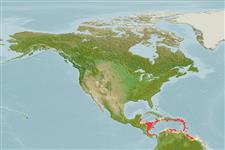Environment: milieu / climate zone / depth range / distribution range
Ecologia
marino associati a barriera corallina; distribuzione batimetrica 0 - 66 m (Ref. 9710). Subtropical; 19°N - 1°S, 89°W - 48°W (Ref. 55171)
Western Atlantic: Bermuda, Florida Keys (USA), Gulf of Mexico, Bahamas; Greater Antilles (including Cuba, Hispanola, Puerto Rico, Jamaica and Cayman Is.), Virgin Is.; Lesser Antilles (island chain south of the British Virgin Islands to Grenada); western Caribbean (ne tip of the Yucatan Peninsula to Colombia, including offshore islands; northern South America (region north of Amazon River including Trinidad and Tobago and off coasts of Colombia, Venezuela. Eastern Atlantic: Ascension Island.
Size / Peso / Age
Maturity: Lm ? range ? - ? cm
Max length : 20.0 cm TL maschio/sesso non determinato; (Ref. 7251)
Short description
Chiavi di identificazione | Morfologia | Morfometria
Raggi dorsali molli (totale) : 11 - 12; Raggi anali molli: 6 - 7. Illicium about twice as long as second dorsal spine (Ref. 26938).
Inhabit shallow reefs (Ref. 9710). Commonly found in areas with sponges; background hue of the fish conforms to that of the dominant sponge in the areas and the ocelli look like openings in the sponge. Feed mainly on fishes, but also eat crustaceans (Ref. 13442). A voracious predator, with many color phases used for camouflage. Oviparous (Ref. 205). Eggs are bound in ribbon-like sheath or mass of gelatinous mucus called 'egg raft' or 'veil' (Ref. 6773). Most common frogfish in the West Indies (Ref. 26938).
Life cycle and mating behavior
Maturities | Riproduzione | Spawnings | Egg(s) | Fecundities | Larve
Oviparous.
Robins, C.R. and G.C. Ray, 1986. A field guide to Atlantic coast fishes of North America. Houghton Mifflin Company, Boston, U.S.A. 354 p. (Ref. 7251)
IUCN Red List Status (Ref. 130435)
Threat to humans
Harmless
Human uses
Pesca: pesca di sussistenza; Acquario: Commerciale
Strumenti
Special reports
Download XML
Fonti Internet
Estimates based on models
Preferred temperature (Ref.
123201): 27.1 - 28.3, mean 27.8 °C (based on 78 cells).
Phylogenetic diversity index (Ref.
82804): PD
50 = 0.5005 [Uniqueness, from 0.5 = low to 2.0 = high].
Bayesian length-weight: a=0.01995 (0.00906 - 0.04395), b=3.01 (2.83 - 3.19), in cm total length, based on all LWR estimates for this body shape (Ref.
93245).
Trophic level (Ref.
69278): 4.3 ±0.7 se; based on diet studies.
Resilienza (Ref.
120179): Alto, tempo minimo di raddoppiamento della popolazione meno di 15 mesi (Fec assumed to be > 10,000).
Fishing Vulnerability (Ref.
59153): Low vulnerability (10 of 100).
Nutrients (Ref.
124155): Calcium = 33.2 [14.6, 80.1] mg/100g; Iron = 0.619 [0.309, 1.196] mg/100g; Protein = 19.5 [17.0, 22.7] %; Omega3 = 0.182 [0.066, 0.484] g/100g; Selenium = 12.3 [4.9, 32.9] μg/100g; VitaminA = 114 [27, 508] μg/100g; Zinc = 0.686 [0.399, 1.116] mg/100g (wet weight);
